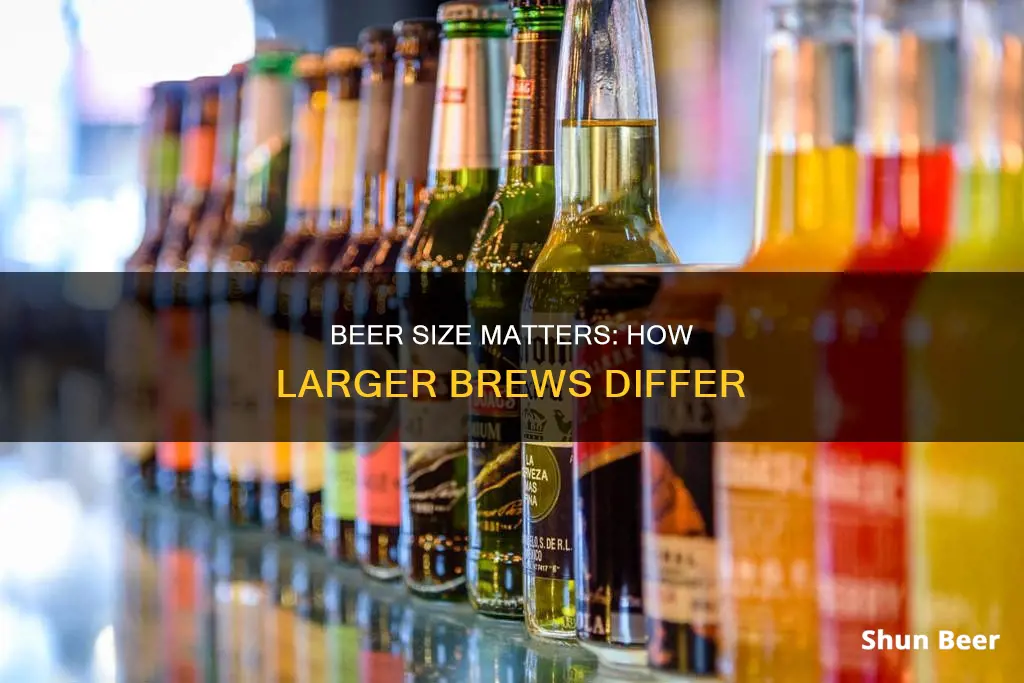
Beer, lager, IPA, stout, and ale are alcoholic drinks with distinct tastes. Beer is an umbrella term for a group of alcoholic drinks, including lager and ale. Lager is a type of beer brewed at a cool temperature using bottom-fermenting yeast. Ales, on the other hand, are produced in a warmer environment with top-fermenting yeast. The brewing process for lager can take several weeks or months, while ale can be ready in as little as two to three weeks.
| Characteristics | Values |
|---|---|
| Fermentation | Ales are fermented with a top-fermenting yeast at warmer temperatures, whereas lagers are fermented with a bottom-fermenting yeast at cooler temperatures |
| Brewing time | Ales can be ready in 2-3 weeks, whereas lagers can take multiple weeks or even months |
| Taste | Ales have a fruitier taste, whereas lagers have a cleaner, smoother, crisper taste |
| Carbonation | Ales are less fizzy than lagers |
What You'll Learn

Lager is a type of beer, brewed at cool temperatures using bottom-fermenting yeast
The distinction between lager and beer has become blurred, and in most countries, when you ask for a beer, you will be served what is technically a lager. Lager is brewed using bottom-fermenting yeast, which means that the yeast used for fermentation settles at the bottom of the vessel. This is in contrast to ales, which use top-fermenting yeast.
Lager is also brewed at cooler temperatures than ales, typically between 35˚–50˚F. This cooler fermentation temperature results in a slower fermentation process, with lagers taking multiple weeks or even months to brew, while ales can be ready in as little as 2-3 weeks.
The birth of the Pilsner style in the 1800s introduced lager to much of the world. Before then, virtually all beer was ale since yeast was not known as an ingredient, and cold fermentation was difficult. With advancements in technology, including the ability to see yeast strains under a microscope and the advent of refrigeration, lager beer rose in popularity in the late 19th and 20th centuries.
Today, lager remains a popular style of beer, known for its mellow taste and lower alcohol content. While ale has made a resurgence in recent years, lager continues to be a favourite among beer drinkers worldwide.
Explore the Difference Between Ales and Lagers
You may want to see also

Ales are top-fermenting and brewed in a warm environment
Top-fermenting tends to yield more flavour as esters, a byproduct of fermentation, are more pronounced in warm temperatures. Ales can generally ferment and age in a relatively short period of time, typically taking around 2-5 weeks.
In contrast, lagers are bottom-fermented and brewed in cooler temperatures. The yeast involved in bottom-fermenting is a hybrid of Saccharomyces cerevisiae and a wild yeast from Patagonia called Saccharomyces eubayanus. Their offspring, Saccharomyces pastorianus, inherited the ability to thrive in colder temperatures.
Because the lager reaction takes longer, bottom-fermented lagers ferment at a low temperature for a longer time, typically taking up to 6-8 weeks. The result is a "'crisper' beer with a less pronounced flavour than an ale."
IPA Beer: Unique Effects and Experiences
You may want to see also

Lagers are fermented slowly over a long period of time
Lager is a type of beer, and all lager is beer, but not all beer is lager. Lager is a German word that translates as "storage", which hints at its method of brewing. Lagers are fermented slowly over a long period of time, at low temperatures, and from the bottom up. This is in contrast to ales, which are brewed in a warm environment and ferment quickly from the top down.
Lager fermentation goes through the same phases as ale fermentation, but it does so much more slowly due to the lower temperatures involved. The lagering process can take weeks or even months longer than a typical ale fermentation. Lager yeast works best at lower temperatures than are necessary for most ale fermentations.
The slower fermentation process of lager means that lager beers usually have a cleaner, crisper aroma and flavour profile than beers produced by top-fermenting ale yeast at warmer temperatures. However, the longer fermentation time and the need for colder temperatures make lager more challenging to brew than ale.
What Makes Beer Gas Tanks Unique?
You may want to see also

Ales are ready to drink in as little as 2-3 weeks
Ales are a type of beer, and they differ from other beers in terms of their brewing process and the time they take to be ready to drink. Ales are brewed in a warm environment, and they ferment quickly from the top down. This is in contrast to lagers, which are brewed at cool temperatures and ferment slowly from the bottom up.
The time it takes for a beer to be ready to drink depends on various factors, such as the style and type of beer, the gravity of the brew, and the yeast used. Generally, ales can be ready to drink in as little as 2-3 weeks, while lagers can take multiple weeks or even months. The faster fermentation process of ales is due to the warmer temperatures and top-fermenting yeast used in their brewing process.
It is important to note that the time frames provided are just guidelines, and the actual time it takes for an ale to be ready to drink can vary. Some sources suggest that ales can be ready in as little as 8 days, while others recommend a longer fermentation time of 3-4 weeks. The specific recipe and brewing techniques used can also impact the required fermentation time. Additionally, personal preference plays a role, as some brewers may prefer their ale with a shorter or longer fermentation time to suit their taste.
To ensure the best results, it is recommended to follow the instructions provided by the ale kit manufacturers, which typically suggest a shorter fermentation time of one week in the primary and one week in the secondary, or two weeks if only single fermentation is used. This is followed by a period of bottle conditioning, which can range from 4-6 weeks, according to the directions provided. However, it is worth noting that some brewers prefer a longer secondary fermentation rather than a lengthy bottle conditioning period, as it results in a more consistent batch of ale.
In conclusion, ales are unique in their brewing process, and one of their distinguishing features is the relatively short time they take to be ready for consumption. With their warm fermentation environment and top-fermenting yeast, ales can be enjoyed in a matter of weeks, making them a popular choice for those eager to taste their homemade brew.
Mexican Beers: Unique Flavors and a Cultural Legacy
You may want to see also

Lagers are lighter in colour than stouts
Lagers and stouts differ in appearance, with stouts being darker in colour than lagers. This is due to stouts having a very high dark malt content, which gives them their distinctive dark colour. Lagers, on the other hand, tend to be lighter in colour.
However, the differences between lagers and stouts go beyond just their appearance. Stouts have a higher malt and lower hop content compared to lagers. This gives stouts a more bitter and intense flavour profile.
The fermentation process also differs between the two types of beer. Lagers are bottom-fermented at around 0-2°C, while stouts are top-fermented at 18-20°C.
In terms of brewing time, lagers can take multiple weeks or even months to brew, while stouts, as a type of ale, can be enjoyed in as little as 2-3 weeks.
Exploring Diverse Beer Markets: A Global Perspective
You may want to see also
Frequently asked questions
Lager is a type of beer. Beer is a broader term that includes lager, IPA, ale, and other styles of beer.
No. Lager is a specific type of beer with distinct properties and a unique taste compared to other types of beer.
Lager is brewed at colder temperatures using bottom-fermenting yeast, resulting in a slower fermentation process. Ale is brewed at warmer temperatures with top-fermenting yeast, leading to a faster fermentation process.
The main difference is in their taste, which is influenced by brewing methods and hop content. IPAs are highly hopped and have a higher bitterness level than lagers.
Lagers and stouts differ primarily in colour. Stouts have a high dark malt content, giving them a darker appearance, while lagers tend to be lighter. Stouts also have higher malt and lower hop content, with a more bitter and intense flavour.







